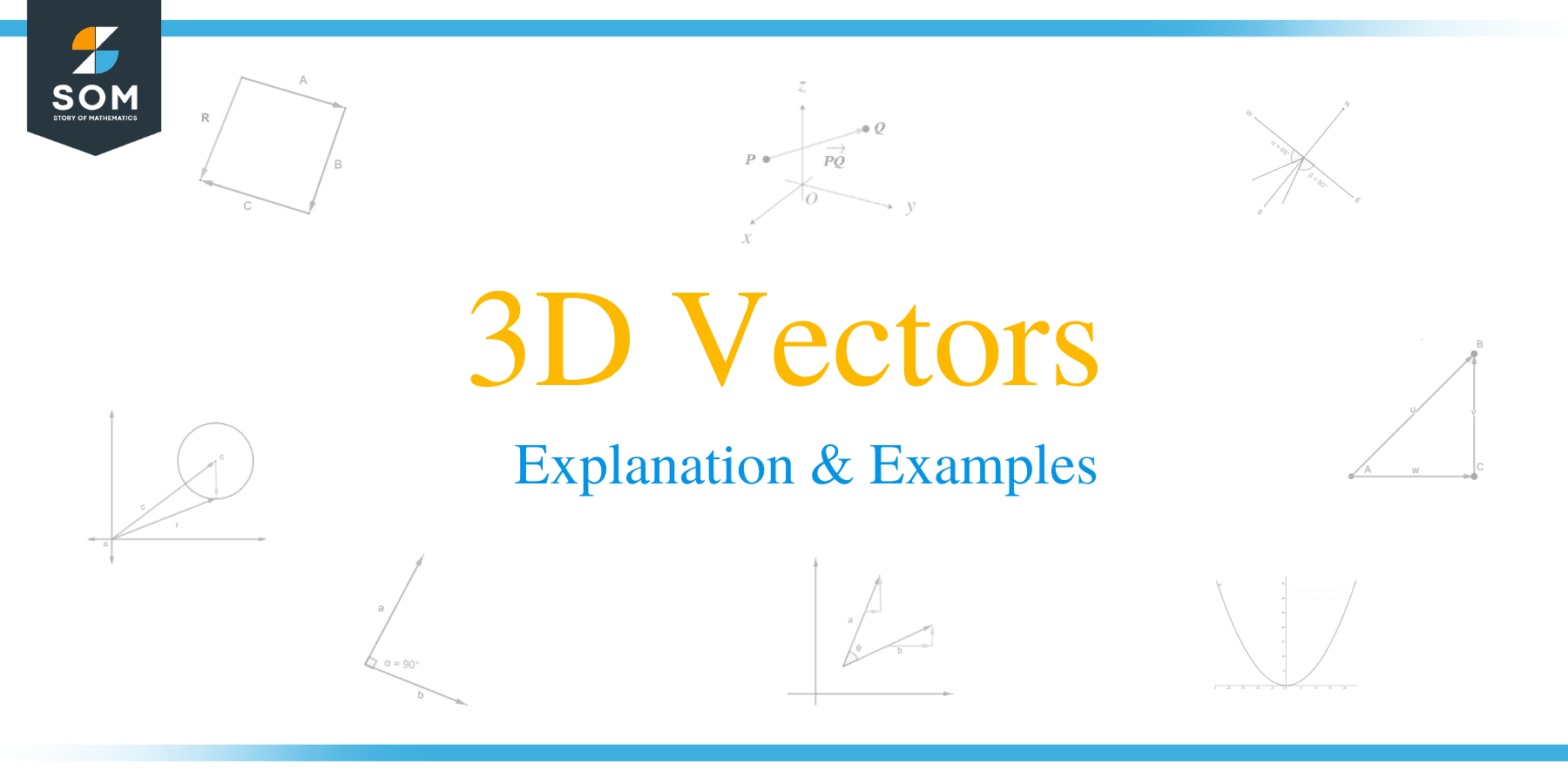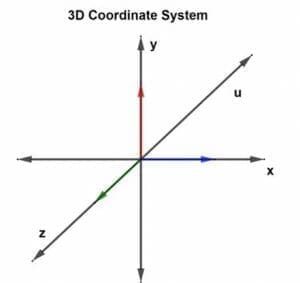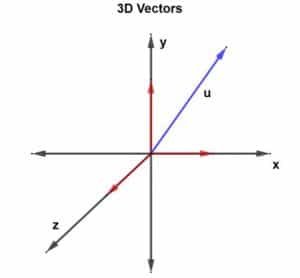- Home
- >
- 3d vector – Explanation and Examples
JUMP TO TOPIC
3D Vectors – Explanation and Examples
 Vectors are very useful in daily life. However, in the real world, things happen in three-dimension. Generally, we learn to solve vectors in two-dimensional space. Still, to expand and develop the use of vectors in more realistic applications, it is essential to explain the vectors in terms of three-dimensional planes.
Vectors are very useful in daily life. However, in the real world, things happen in three-dimension. Generally, we learn to solve vectors in two-dimensional space. Still, to expand and develop the use of vectors in more realistic applications, it is essential to explain the vectors in terms of three-dimensional planes.
A 3-D vector is defined as:
“A three-dimensional vector is a line segment drawn in a 3-D plane having an initial point referred to as tail, and final point referred to as the head. Like a normal vector in the 2-D plane, a 3-D vector also has some magnitude and direction”.
In this topic, we shall discuss the following points in detail:
- What is a 3-D vector?
- How to find the magnitude of a 3-D vector?
- How to calculate the angle between two 3-D vectors?
- How to draw a 3-D vector?
- Examples
- Problems
What Is A 3-D Vector?
A 3-D vector is a vector represented in a 3-D plane having three coordinates; x, y, and z.
As in the previous sections, we have learned and discussed the vectors in 2-dimensional space. To avoid the computational complexity and simplify the idea so that we can understand the concept easily, it’s time to learn about 3-D vectors.
For example, if we need to specify the direction of any rigid object or body such as cars, airplanes, robots, etc., one would normally think that he needs three coordinates to define the position of the objects x, y, and z-axis and that is completely correct. So, to describe the impact of all the features, we need to use three-dimensional space.
Similarly, if we consider a map in 2-D, it’s only useful for navigating from one point to another. Still, if we need to specify various landscapes and environments, only a 2-D description of a map is not enough. That’s why it is necessary to understand the concept of 3-D vectors in a 3-D coordinate system and their properties.
A 3-D vector is like a 2-D vector in all aspects, but in the case of a 3-D vector, we need to keep track of one more direction. 3-D vector operations are analogous to 2-D operations with just an added computational step. We can do various computations like finding the angle between two vectors, scalar multiplications, etc.
3-D Coordinate System
Now, the first question is, “What is a 3-D coordinate system?” A 3-D coordinate system has 3 dimensions or can be regarded as having 3 perpendicular axes: x, y, and z-axes. Such a system is called a 3-dimensional rectangular coordinate system.

A vector drawn in a 3-D plane and has three coordinate points is stated as a 3-D vector. There are three axes now, so this means that there are three intersecting pairs of axes. Each pair forms a plane, xy-plane, yz-plane, and xz-plane. A 3-D vector can be represented as u (ux, uy, uz) or <x, y, z> or uxi + uyj + uzk.
How To Find The Magnitude Of A 3-D Vector?
The magnitude of 3-D vectors is calculated in a similar way with the addition of one more coordinate.
|u| = √((ux)^2 + (uy)^2 + (uz)^2)
Where ux, uy, and uz are the magnitudes of coordinate axes.
As we have already discussed, the concept of a 3-D vector is not different from that of a 2-D vector, except now there is one more dimension in the 3-D vector. The magnitude of a vector is always positive, as the common mistake in computing the magnitude of a vector is that we forget the absolute sign. Only the magnitude of the null vector is zero.
Let us have a better understanding of the concept with the help of an example.
Example 1
Calculate the magnitude of the following 3-D vectors.
- u = (3,4,5)
- v = <2,5,6,>
- s = 3i + 8k
Solution
Let’s first consider equation 1:
u = (3,4,5)
|u| = √ ((3)2 + (4)2 + (5)2)
|u| = √ (9 + 16 + 25)
|u| = 7.07
Now, consider the equation 2:
v = <2,5,6,>
|v| = √ ((2)2 + (5)2 + (6)2)
|v| = √ (4 + 25 + 36)
|v| = 8.06
Let’s evaluate for the equation 3:
|s| = √ ((3)2 + (0)2 + (8)2)
|s| = √ (9 + 0 + 64)
|s| = 9.05
So, in the above examples we have calculated magnitudes of 3-D vectors.
What Is A Displacement Vector?
The displacement vector is defined as:
“A vector that explains about change in the position of the object is called a displacement vector.”
Let us consider a vector AB whose starting point is A (x1, y1, z1), and the ending point is B (x2, y2, z2). It has some magnitude and direction, and in this case, the direction is defined to be from A to B.
The coordinates of the displacement vector are
AB = (x2 – x1 , y2 – y1 , z2 – z1)
Therefore, the magnitude is given as:
|AB| = √ ((x2 – x1)^2 + (y2 – y1)^2 + (z2 – z1)^2)
Let’s conduct some examples.
Example 2
Given that the coordinates of two points are A (4,6,8) and B (7,8,4). Find out the distance between two points.
Solution
To find the distance between two points in a 3-dimensional plane, we will use the following formula:
|AB| = √ ((x2 – x1)^2 + (y2 – y1)^2 + (z2 – z1)^2)
|AB| = √ ((7 – 4)^2 + (8 – 6)^2 + (4 – 8)^2)
|AB| = √ ((3)^2 + (2)^2 + (-4)^2)
|AB| = √ (9 + 4 + 16)
|AB| = √ (29)
|AB| = 5.38
The distance between the two points is 5.38 m.
Direction Of A Vector Determined By The Unit Vector
A unit vector is defined as a type of vector whose magnitude is always equal to 1. So, the unit vector describes the direction of a vector v given that the magnitude of the vector is |v|.
Then, the direction vector is given as,
Û = U / |U|
Let’s solve some examples to imply this concept on 3-D vectors.
Example 3
Find out the direction and magnitude of the given 3-D vector PQ (3,5,6).
Solution
The magnitude of the given vector is given as:
|PQ| = √ ((3)2 + (5)2 + (6)2)
|PQ| = √ (9 + 25 + 36)
|PQ| = 8.366
The direction of the 3-D vector is given by unit vector as follow:
UPQ = PQ / |PQ|
UPQ = [3, 5, 6] / 8.366
Example 4
Find out the direction and magnitude of the given vector AB = 5i + 3j + 2k
Solution
The magnitude of the given vector is given as:
|AB| = √ ((5)^2 + (3)^2 + (2)^2)
|AB| = √ (25 + 9 + 4)
|AB| = 6.166
The direction of the vector is given by unit vector as follow:
UAB = AB / | AB |
UAB = (5i + 3j + 2k) / 6.166
Angle Between Two 3-D Vectors
Let us consider two 3-D vectors u and v. The scalar product of two vectors in 3-D space is given as:
u.v = |u| |v|.cosθ
where |u| and |v| are the magnitudes of the two vectors u and v and θ is the angle between the two vectors.
To understand the concept of the angle between two 3-D vectors, let’s revise the concept of a scalar product or dot product. The scalar product is defined as the product of two 3-D vectors, which gives a scalar quantity in return.
So, the angle between two 3-D vectors is given as the dot product of the two vectors divided by the product of the magnitudes of two vectors.
The following steps must be followed to calculate the angle between two 3-D vectors:
- Firstly, calculate the magnitude of the two vectors.
- Now, start with considering the generalized formula of dot product and make angle θ as the main subject of the equation and model it accordingly,
u.v = |u| |v|.cosθ
cosθ = u.v / |u| |v|
θ = arccos (u.v / |u| |v|)
- Use the standard algebraic formula to calculate the dot product of two vectors.
Similarly, the angle between two 3-D vectors can also be calculated by using a cross product by following the same steps as discussed above, and the only difference is that it will have sin instead of cos and generalized formula of cross-product in order two find out the result.
Let us understand the concept with the help of an example.
Example 5
Given that there are two vectors u = 2i + 2j + 3k and v = 6i + 3j + 1k. using the formula of dot product calculate the angle between the two vectors.
Solution
Follow the following steps to calculate the angle between two vectors.
- Start with the formula of the dot product.
- Find out the magnitude of the two vectors.
- Calculate the dot product of two vectors.
- Divide the product of two vectors by the product of the magnitude of two vectors.
- Calculate the value of θ by putting into the equation given below
θ = arccos (u.v / |u| |v|)
Magnitude of u is given as,
|u| = √ ((2)^2 + (2)^2 + (3)^2)
|u| = √ (4 + 4 + 9)
|u| = √ (17)
Magnitude of v is given as,
|v| = √ ((6)^2 + (3)^2 + (1)^2)
|v| = √ (36 + 9 + 1)
|v| = √ (46)
Now, calculating the dot product of two vectors,
u.v = (2i + 2j + 3k) . (6i + 3j + 1k)
u.v = ((2.6)(1) + (2.3)(1) + (3.1)(1))
u.v = 12 + 6 +3
u.v = 21
Now, as a final step put all the values into the formula in order to calculate the value of θ.
θ = arccos (u.v / |u| |v|)
θ = arccos (21 /√ (17).√ (46) )
θ = arccos (21 / (4.12). (6.78) )
θ = arccos (0.75)
θ = 0.7227 rad
So, converting the angle into degrees,
θ = 41.36º
How To Graph A 3-D Vector?
To graph a 3-D vector, we will consider the following analogy.
Let us consider a 3-D coordinate system with 3 axes x, y, and x-axes, which can also be denoted in standard unit vectors such as i, j, and k. As shown in the figure, the labeled sides are positive x-axes, positive y-axes, and positive z-axis, and the unlabeled sides are regarded as negative axes. The intersection of three perpendicular axes is called origin O. So, with these axes, any point A in space can be assigned three coordinates A = (A1, A2, A3).
Let’s consider a person standing near the corner of a room and looking down at the point where walls meet the floor. So, that intersection can be visualized as a 3-D axis. The floor and the wall to the left of the person intersecting each other in a line can be regarded as positive x-axes. The floor and the wall intersecting towards the right side of the person are y-axes. The walls intersecting in a vertical line are positive z-axis. The opposite part of each is regarded as a negative part of each axis.
A vector is drawn as blue with its tail fixed at the origin and arrowhead pointing in the direction in the figure below. Now, draw the vector’s projection on three axes, which are shown in red, which are the coordinates of the given vector.

Just as in two-dimension, we can also denote a three-dimensional vector in terms of a unit vector i, j, and k. These are the unit vectors in the above positive axes. A 3-D vector can be dented as A = A1i + A2j + A3k where A1, A2, and A3 are the coordinates of a 3-D vector.
There are various 3-D vectors plotting and graphing software that can be used to visualize and draw 3-D vectors and understand their specifications properly.
Practice Problems
- Calculate the magnitude of the following 3-D vectors: u = 5i + 10j + 8k AB = 1i + 2j + 5k <3,5,8>
- Given that the coordinates of two points are A (5,0,8) and B (9,5,4). Find out the distance between two points.
- Find out the angle between the given vectors u <-8,7,2> and v <-6,4,3>.
- Find out the direction vector of u <2,6,5>
- Find out the direction and magnitude of the given vector AB = -8i + 5j + 9k
- Given that there are two vectors u = 8i + 6j + 9k and v = 3i + 3j + 5k. using the formula of dot product calculates the angle between the two vectors.
- A book is lying on the table such that a force F1 = 1i + 1j + 1k acting in an upward direction and a force F2 = -(1i + 1j + 1k) acting in the downward direction so that two forces are equal in magnitude and opposite in direction. Calculate the angle between the two forces.
Answers
- 13.8 5.5 9.9
- 7.54
- 55.6°
- (<2, 6, 5>)/ (√65)
- |AB| = 13 , UAB =(-8i + 5j + 9k)/ (13)
- 17.2°
- 180°
All the vector diagrams are constructed using GeoGebra.
